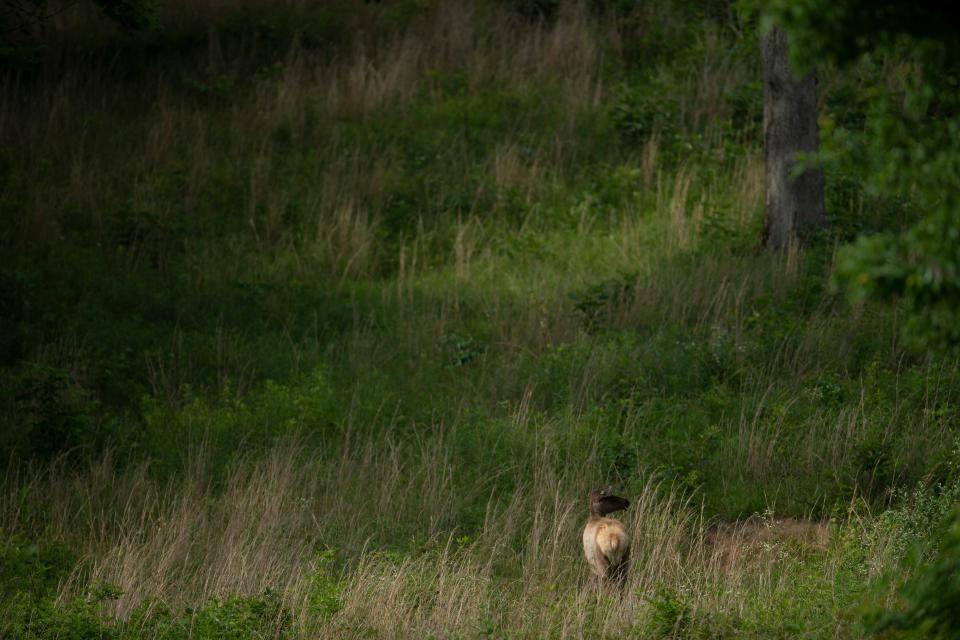25 years ago, you couldn't find elk in Kentucky. Now there are hundreds of them.
EVANSVILLE, Ind. — The Shawnee called them "wapiti," their word for "white deer" or "white-rumped deer."
Awed by their impressive size and enormous antlers, European settlers encountering them in the forests and grasslands of North America called them elk.
Once abundant in the Eastern United States, the eastern elk subspecies has been extinct since the mid-1800s. Only in the last two decades has it become possible to see an elk without traveling west to places such as Yellowstone National Park.
One of the places you can find elk now? Kentucky.

Elk 'now thriving' in the commonwealth
This year marks the 25th anniversary of elk restoration in the commonwealth. Since the late 1990s, other states also have begun reintroducing elk, including Tennessee, North Carolina, West Virginia, Virginia, Missouri, Georgia and Wisconsin.
But the elk now roaming parts of Kentucky and those other states are a different subspecies, said John Hast, the Kentucky Department of Fish and Wildlife Resource's elk and bear program coordinator.
"The eastern elk were basically gone by the Civil War," he said.
Since 1997, more than 1,500 elk from seven western states have been released into 16 southeastern Kentucky counties. It is about a 4.3 million acre area, Hast said. It's now believed to be the biggest elk herd east of the Rocky Mountains.
"They really fit the habitat well here," he said.

Hast said the elk have adapted to the timbered habitat of Kentucky's reclaimed mine land and forests so well that they are beginning to take on more deer-like behaviors, such as gathering in smaller groups instead of the larger herds seen in the West.
The elk have not only thrived in Kentucky, but also have helped stock reintroduction programs in other states, including West Virginia and Wisconsin.
However, don't expect to see unfettered elk in the wild spaces of Western Kentucky, where there is more farmland than unbroken forest.
"There are no plans to move them west," Hast said. "A soybean or cornfield would be like a magnet to an elk herd."
Where you can find elk in Western Kentucky
It is possible to see elk in a more controlled environment without leaving Western Kentucky, though.
Elk and bison roam free within an enclosed 700-acre area of mixed woods and prairie at Land Between the Lakes National Recreation Area between Kentucky and Barkley lakes in Western Kentucky and Tennessee. Visitors can pay to drive through the Elk & Bison Prairie there.
Ironically, the Land Between the Lakes elk arrived in Western Kentucky in 1996, a year before state wildlife officials gave the go ahead to reintroduce them in Eastern Kentucky.

Wildlife technician Curtis Fowler of the U.S. Forest Service has worked with the Land Between the Lakes elk for 15 years. He said the elk there were initially established by the Tennessee Valley Authority before the Forest Service managed the area.
The original idea was to reintroduce the elk to the wild from Land Between the Lakes once their survival was ensured, Fowler said. That changed when people became concerned about the impacts on agriculture.
Although enclosed, Fowler said the herd is mostly wild. There are currently 68 elk there, Fowler said, but elk typically calve around the end of May.
"We do what we can to let them take care of themselves," he said.
Seeing elk calves is unlikely, at least for the first few months, Fowler said. Mother elk hide their calves alone in the woods to feed until they are old enough to keep up with adults. Hiding them also helps protect the calves from predators such as coyotes, bob cats, black vultures and bald eagles.
As the weather warms, the best time to see elk at LBL is in the hour before sunset or at dawn, Fowler said.

A bull elk can weigh up to 700 pounds and stand five feet tall. Their impressive vocalizations, called bugling, can be heard up to a mile away.
"They are just neat animals because they are so big. When you compare an elk to a deer, it's kind of surprising how much bigger they are," Fowler said. "You don't have to go to Yellowstone. There is a pretty good chance of seeing something you can't see every day right here at Land Between the Lakes."
Mark Wilson covers education and environment at the Courier & Press. Contact him at mark.wilson@courierpress.com.
This article originally appeared on Evansville Courier & Press: Where can I find elk in Kentucky? Restoration effort brings animal back.

